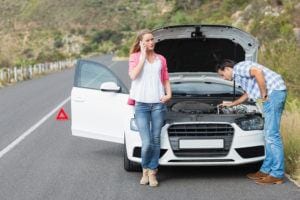 Whether you’ve only recently passed your practical test or are a seasoned road user with many years of driving experience, breaking down can be a very distressing and potentially dangerous experience. There is no good time to breakdown and even those that take vehicle maintenance and servicing very seriously can find themselves stranded at the roadside. Here we reveal just what you should do if you breakdown so you can deal with the situation with confidence.
Whether you’ve only recently passed your practical test or are a seasoned road user with many years of driving experience, breaking down can be a very distressing and potentially dangerous experience. There is no good time to breakdown and even those that take vehicle maintenance and servicing very seriously can find themselves stranded at the roadside. Here we reveal just what you should do if you breakdown so you can deal with the situation with confidence.
Know where to stop
If you are experiencing mechanical difficulties whilst travelling on the motorway then you must pull over on the hard shoulder. The hard shoulder should never be used for a toilet break, to use your mobile phone or to check a map, however quick, but if you need to stop for emergency purposes and you cannot make it to a safer place off the motorway the hard shoulder can offer a safe haven. When using the hard shoulder stop as far left as possible and turn your wheels to the left also.
When using any other road, finding a safe place to stop and call for help should be your primary objective.
Use your lights correctly
For many drivers finding your lights at the best of times can cause chaos but when stopping in an emergency you must use your lights correctly to warn other road users, and protect yourself and your passengers. When stopping, leave your sidelights on and switch on your hazard warning lights.
Exit your vehicle safely
When exiting your vehicle you should follow the ‘think left’ rule as you have done with coming to a stop. You and your passengers should exit the vehicle on the left hand side, however animals should be left inside the vehicle where possible. If you need to remove the animals from the vehicle, exit on the left and retreat to the verge ensuring they are kept under control at all times.
Whether you have broken down in the day or at night, you should wear a reflective jacket – we recommend packing at least one in your in-car breakdown kit. Also on many drivers’ lists of breakdown essentials is the warning triangle; this piece of equipment can be useful when broken down at the roadside but should not be used on the hard shoulder.
Call for help
Calling for help is important as whilst some drivers may be confident enough to complete basic repairs many more will need professional assistance from a qualified mechanic to get moving again. Whatever your level of experience or the simplicity of the repair, never attempt to fix a vehicle on the hard shoulder.
If you are on the motorway and don’t have a mobile phone to hand, walk to the nearest emergency phone on your side of the carriageway, never try to cross. When calling for help use the driver location signs and give full details of your breakdown whilst informing the operator if you are a vulnerable motorist.



